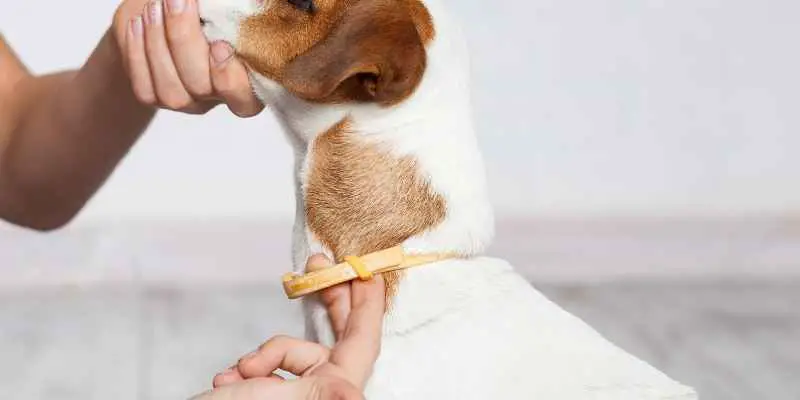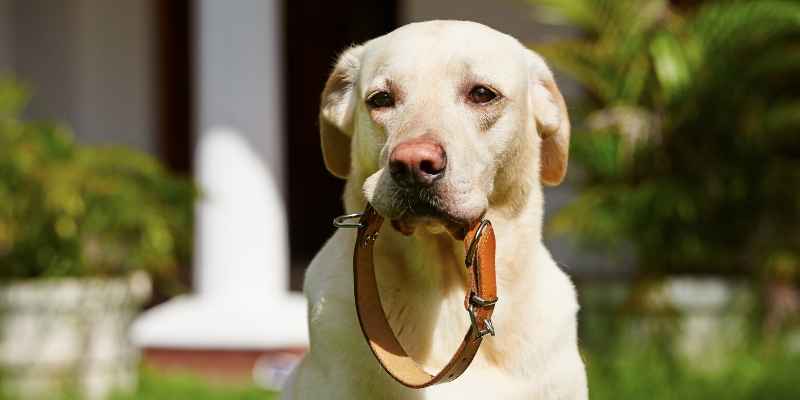Are you interested in a particular type of collar? Then use the table of contents below to jump to the most relevant section. And you can always go back by clicking on the black arrow in the right bottom corner of the page. Also, please note that some of the links in this article may be affiliate links. For more details, check the Disclosure section at the bottom of the page.
Getting a good dog collar is an essential thing for training and identification of your dog. Your dog will spend most of its life in a dog collar. You have to make sure that the dog collar is comfortable and not too tight. Finding a good dog collar depends upon the type of dog and size.
An adjustable choker is probably the best choice regardless of the breed you have. It allows you to go from one size to another in a second.

What is the ideal space between a dog’s collar and its neck?

Here’s what you do to determine the tightness of the collar around the dog neck. Just put two fingers between the neck and the collar. If you can easily rotate them, then your pup is good. Make sure that the collar does not cause breathing problems in puppies.
The second method is to measure the area of the dog’s neck. Add two inches to the measurements, and that would be the ideal length of the collar.

Is it bad when the dog collar is too tight?
The tight dog collar can cause problems in the dog. It makes your pet uncomfortable, and in some cases, it can even choke your dog. Sometimes, tight collars might cause coughing and vomiting in puppies. So, if you have a feeling that choker is too firm, use the finger rule.
Tight collars can also lead to strangulation, trachea, and esophagus issues in dogs. Some other symptoms include nerve damage, fainting, transient paralysis, and even death. All in all, it’s not a joke to make it right.

How tight should different types of dog collars be?
Chain Collar Tightness
A chain collar is sometimes called choke collar. A chain collar is available in different sizes. First, measure your dog’s neck. Then, add 2-3 inches in the measurement and choose the chain that is about this figure. A choke chain should fit around the canine throat; it must not touch dog ears. The recommended chain size is six inches.
Prong or Pinch Collar Tightness
The prong or pinch collar has a leash made using the chain. When you pull the control loop, touch the skin of the dog neck. The correct way to put the prong collar is under the dog jawline. This spot will also prevent tightness, and the collar should not be loose or going away from the neck. It is the wrong way. The Prong collars are available in medium, small and big size.
Shock Collars Tightness
Shock collars use the electric current mechanism that makes your pup feel the signal when needed. Therefore, shock collar needs more tightness as compared to other collars. The collar contact point should touch the puppy neck and apply some pressure on the neck. It should fit the pup neck and should not move away from the neck.
Flea Collar Tightness
Flea/tick collars have chemicals. It can protect your four-legged friend from fleas. The flea collar should fit around the dog’s neck and make the skin contact as well. You should be able to put your fingers below the collar. Cut any extra length. But still, make sure it is not TOO tight.

Dog Collar Tightness. Summary
Dog collar is used to control and train your dog or a puppy. It has another purpose too, for instance, it can be used to identify your dog. So your pup mustn’t suffer from wearing that collar. The collar tightness and size should match your puppy or dog size. And using the tips from this guide, you can always make sure that your pet is comfortable wearing his or her choker at all times.
Credits: thanks for the photo to Canva.



